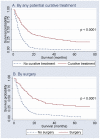Prognostic factors for esophageal squamous cell carcinoma--a population-based study in Golestan Province, Iran, a high incidence area
- PMID: 21811567
- PMCID: PMC3141005
- DOI: 10.1371/journal.pone.0022152
Prognostic factors for esophageal squamous cell carcinoma--a population-based study in Golestan Province, Iran, a high incidence area
Abstract
Golestan Province in northern Iran is an area with a high incidence of esophageal squamous cell carcinoma (ESCC). We aimed to investigate prognostic factors for ESCC and survival of cases in Golestan, on which little data were available. We followed-up 426 ESCC cases participating in a population-based case-control study. Data were analyzed using the Kaplan-Meier method and the Cox proportional hazard models. Median survival was 7 months. Age at diagnosis was inversely associated with survival, but the association was disappeared with adjustment for treatment. Residing in urban areas (hazard ratio, HR = 0.70; 95% CI 0.54-0.90) and being of non-Turkmen ethnic groups (HR = 0.76; 95% CI 0.61-0.96) were associated with better prognosis. In contrast to other types of tobacco use, nass (a smokeless tobacco product) chewing was associated with a slightly poorer prognosis even in models adjusted for other factors including stage of disease and treatment (HR = 1.38; 95% CI 0.99-1.92). Opium use was associated with poorer prognosis in crude analyses but not in adjusted models. Almost all of potentially curative treatments were associated with longer survival. Prognosis of ESCC in Golestan is very poor. Easier access to treatment facilities may improve the prognosis of ESCC in Golestan. The observed association between nass chewing and poorer prognosis needs further investigations; this association may suggest a possible role for ingestion of nass constituents in prognosis of ESCC.
Conflict of interest statement
Figures
References
-
- Kamangar F, Dores GM, Anderson WF. Patterns of cancer incidence, mortality, and prevalence across five continents: defining priorities to reduce cancer disparities in different geographic regions of the world. J Clin Oncol. 2006;24:2137–2150. - PubMed
-
- Jemal A, Center MM, Desantis C, Ward EM. Global patterns of cancer incidence and mortality rates and trends. Cancer Epidemiol Biomarkers Prev. 2010;19:1893–1907. - PubMed
-
- Blot WJ, McLaughlin JK, Fraumeni JF. Esophageal Cancer. In: Schottenfeld D, Fraumeni JF, editors. Cancer Epidemiology and Prevention. New York: Oxford University Press; 2006. pp. 697–706.
-
- Trivers KF, Sabatino SA, Stewart SL. Trends in esophageal cancer incidence by histology, United States, 1998–2003. Int J Cancer. 2008;123:1422–1428. - PubMed
-
- Steevens J, Botterweck AA, Dirx MJ, van den Brandt PA, Schouten LJ. Trends in incidence of oesophageal and stomach cancer subtypes in Europe. Eur J Gastroenterol Hepatol. 2010;22:669–678. - PubMed
Publication types
MeSH terms
LinkOut - more resources
Full Text Sources
Medical



